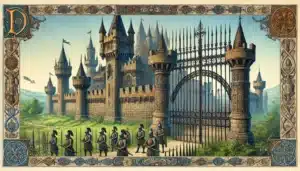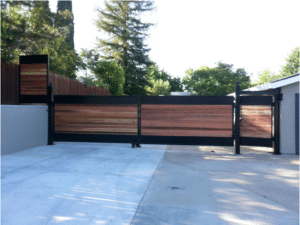Hello there, folks! Today, we’re diving into a topic that’s close to my heart and workshop: the differences between wrought iron and steel. You see, not too long ago, I found myself standing in my backyard, staring down at the plans for a new garden gate. The question wasn’t just about what would look best, but what would stand the test of time and the elements. That day, the choice between wrought iron and steel became more than just a material selection; it was about crafting a legacy. So, let’s roll up our sleeves and explore these two stalwarts of the material world, shall we?
The Basics: Understanding the Materials
Wrought Iron
When we talk about wrought iron, we’re stepping into a bit of a time machine. This material has a rich history, used for everything from knights’ swords to delicate garden gate scrolls. Wrought iron is known for its low carbon content, usually less than 0.08%, which gives it some distinctive properties. It’s incredibly malleable, allowing it to be heated and worked into intricate designs. This low carbon content also lends it some resistance to corrosion, outperforming many other metals. One of its most charming features is its grain—like wood, wrought iron has a grain resulting from the slag (impurities) in the metal, giving it a unique texture and appearance.
Steel
If wrought iron is the distinguished elder, steel is the robust, versatile offspring that took the world by storm. Steel’s defining characteristic is its carbon content, which ranges from 0.2% to 2.1%, depending on the type. This variation gives steel its incredible range of properties, from the strength and durability needed for skyscrapers and bridges to the balance of hardness and flexibility in a chef’s knife.
Steel isn’t a one-note material. There’s carbon steel, the most common variety, primarily made of iron and carbon. Stainless steel, alloyed with chromium (and sometimes nickel), offers unbeatable rust and corrosion resistance. Alloy steels, which include elements like manganese, molybdenum, or tungsten, achieve specific properties for specialized applications. Steel’s versatility and strength have made it the backbone of modern construction and manufacturing.
Key Differences Between Wrought Iron and Steel
Composition and Manufacturing
The heart of the distinction between wrought iron and steel lies in their carbon content. Wrought iron, with its carbon content under 0.08%, is nearly pure iron with small amounts of slag, giving it a fibrous structure like wood grain. Historically, wrought iron was produced through a labor-intensive process involving heating iron ore and working the metal to remove impurities.
Steel, with a carbon content ranging from 0.2% to 2.1%, is harder, stronger, and more versatile. Modern processes like the Bessemer Process, basic oxygen steelmaking, and electric arc furnaces have revolutionized steel production, allowing for a vast range of types with precisely controlled properties for various applications.
Physical and Mechanical Properties
The differences in carbon content and manufacturing result in distinct properties for wrought iron and steel. Wrought iron, being softer and more malleable, is easier to work into intricate designs but doesn’t have the same strength and hardness as steel. Its fibrous structure offers resistance to fatigue and cracks, making it durable but not as strong under load as steel.
Steel’s higher carbon content makes it significantly stronger and harder, enabling it to support greater weights and withstand higher stresses. However, this strength comes with a trade-off in ductility and workability. Steel’s variety means its weight can vary significantly based on the type and composition, offering options for lightweight and heavy-duty applications.
In terms of corrosion resistance, wrought iron naturally outperforms basic carbon steel thanks to its slag inclusions, which provide some protection against rust. However, stainless steel, with its chromium content, offers superior resistance to corrosion, making it ideal for environments where rust is a significant concern.
Aesthetic and Applications
Aesthetically, wrought iron provides a timeless, classic look, ideal for decorative gates, fencing, and old-world-style furniture. Its ability to be worked into detailed, ornate designs makes it a favorite for architectural accents and artwork.
Steel’s applications are almost limitless. From the structural framework of skyscrapers and bridges to the precision of surgical instruments and the everyday utility of kitchen utensils, steel’s role in modern infrastructure and tools is unparalleled. Its aesthetic can range from industrial and utilitarian to sleek and modern, depending on the finish and context.
Cost Considerations
Wrought iron, with its niche market and the craftsmanship required to work it, tends to be more expensive than basic steel. However, the cost of steel can vary widely based on its type and quality, with specialized alloys and stainless steels commanding higher prices.
When considering cost, it’s important to weigh long-term value and specific needs over upfront costs. For instance, the initial investment in stainless steel might be higher, but its durability and low maintenance could make it more cost-effective over time.
Choosing the Right Material for Your Project
Choosing between wrought iron and steel often comes down to balancing aesthetic desires with functional needs. For a garden gate in a humid climate, wrought iron’s corrosion resistance might be preferable, while a structural support would benefit from steel’s strength. Personal preference plays a significant role, too; the classic look of wrought iron might be the deciding factor for decorative projects, while steel’s versatility might appeal for more utilitarian applications.
Maintenance Tips and Longevity
Both wrought iron and steel benefit from regular maintenance to ensure their longevity. Wrought iron should be inspected for rust spots, which can be addressed with sanding and repainting. Protective coatings can help preserve its appearance and structural integrity.
Steel, especially if not stainless, requires similar vigilance against corrosion. Regular cleaning and timely repairs to any scratches or damage to protective coatings will help prevent rust.
With proper care, both materials can last for decades, making either a worthy investment. Choosing between wrought iron and steel ultimately comes down to understanding the unique benefits and limitations of each, ensuring that the selected material aligns with the project’s needs and the creator’s vision.
Read more: Wrought iron vs wood vs vinyl fencing
| Feature | Wrought Iron | Steel |
|---|---|---|
| Carbon Content | Less than 0.08% | 0.2% to 2.1% |
| Strength | Lower than steel, but durable | Very high, varies by type |
| Malleability | High, easy to work and shape | Lower than wrought iron, varies by type |
| Corrosion Resistance | Good, better than carbon steel | Varies, stainless steel has excellent resistance |
| Aesthetic | Classic, ornamental | Versatile, ranges from industrial to sleek |
| Applications | Decorative items, gates, fencing | Wide range, from construction to utensils |
| Manufacturing Process | Traditional, labor-intensive | Modern, efficient, varies by steel type |
| Cost | Generally higher due to craftsmanship | Varies widely, from affordable to premium |
Conclusion
Whether you’re drawn to the timeless beauty and craftsmanship of wrought iron or impressed by the strength, versatility, and innovation behind steel, there’s no wrong choice. Each material has its place, purpose, and story to tell. I encourage you to approach your next project with both curiosity and confidence, armed with the knowledge to select the material that best suits your vision and requirements.
And, as always, if you’ve got questions or are pondering over what material to choose for your next endeavor, don’t hesitate to reach out. I’m here to share insights, experiences, and maybe a few dad jokes along the way. Happy building, crafting, and creating!
FAQs Section
Q: Can wrought iron be as strong as steel?
A: While wrought iron is durable and has a certain resilience due to its fibrous structure, it does not match the strength and hardness that steel can offer, especially in load-bearing applications.
Q: Is stainless steel really worth the extra cost?
A: For applications where corrosion resistance is crucial—like outdoor structures, marine environments, or culinary tools—stainless steel’s higher upfront cost can be justified by its longevity and low maintenance needs.
Q: Can I weld wrought iron to steel?
A: Yes, but it requires specific techniques and considerations due to their different properties. A skilled welder can successfully join these materials, though it’s essential to account for their differences in expansion rates and melting points.
Q: Does wrought iron require more maintenance than steel?
A: Wrought iron does require regular maintenance to prevent rust and maintain its appearance, especially if it’s exposed to the elements. Steel, depending on the type (particularly non-stainless varieties), also requires maintenance to prevent corrosion.
Q: Are there any modern alternatives that mimic the look of wrought iron?
A: Yes, there are modern materials and treatments that can replicate the look of wrought iron, including certain types of powder-coated aluminum or steel. These alternatives offer the aesthetic appeal of wrought iron with potentially less maintenance and different physical properties.



